Week 1: Reading skills for university study
Use 'Print preview' to check the number of pages and printer settings.
Print functionality varies between browsers.
Printable page generated Friday, 17 May 2024, 9:01 AM
Week 1: Reading skills for university study
Introduction
A good deal of a student’s time is spent reading textbooks, academic books, journals, encyclopaedias, newspapers, magazines and websites. These are the sources of information and ideas that are needed to understand a subject.
Watch the introductory video from the author, Anna Calvi, as she introduces the course and this week:
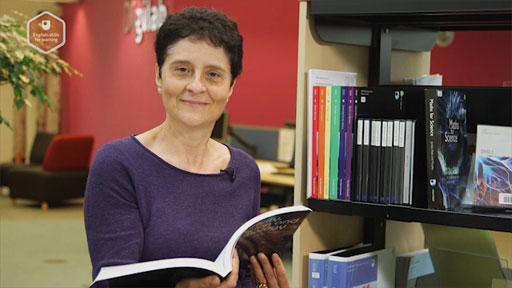
Transcript
Welcome to Week 1. This week you focus on the reading skills that are needed to make the most of a university education. You will look at the different sources of information university students normally read.
University readings can be long and approaching them can be daunting. You will consider some of the challenges students sometimes face when approaching these readings and learn an active reading method which allows you to break a reading task in to small manageable steps. For some activities you will need access to a printer.
Finally, you will learn a range of techniques to produce well organised notes that can be used when writing an assignment.
If you decide to go to university, you will have to prepare for exams and
This week you start by looking at the different texts that university students read. You will then learn to follow an active reading method that will help you read academic texts and make notes in the most effective way. For some activities this week, and throughout the course, you will need access to a printer.
By the end of this week, you will be able to:
- identify different texts university students read
- understand the most effective reading strategies
- actively read an academic text
- make useful notes.
The Open University would really appreciate a few minutes of your time to tell us about yourself and your expectations for the course before you begin, in our optional start-of-course survey. Participation will be completely confidential and we will not pass on your details to others.
1 Getting started: looking at academic and specialist sources
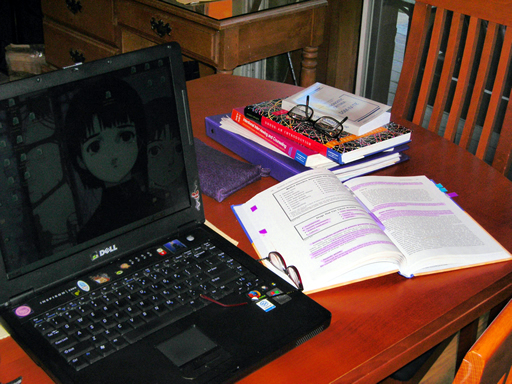
In this section, you will consider first the texts you are already familiar with and then the key resources university students need to read when studying.
These resources provide the information, data, theories and
In order to read and use these sources effectively, it is important to know which types of source they are, what they look like and where they can be found.
1.1 What do you read?
Reading is an activity many of us are familiar with both at home and at work. Reading is fundamental to modern life and this means that we are surrounded by texts; that is, pieces of writing such as magazines, text messages and advertisements. The next activity helps you to consider the different texts people read every day.
Activity 1
Shown below are various people’s reading habits (Figure 2). Which of these reading habits are similar to your own? Make some notes in the box and then read my comment.
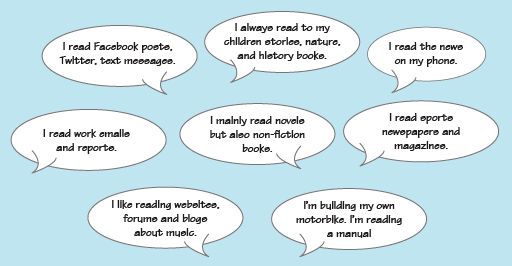
An image of people’s reading habits contained in speech bubbles. The bubbles contain the following text: I read Facebook posts, Twitter, text messages. I read work emails and reports. I always read to my children stories, nature, and history books. I mainly read novels but also non-fiction books. I like reading websites, forums and blogs about music. I read the news on my phone. I read sports newspapers and magazines. I’m building my own motorbike. I’m reading a manual!
Comment
The answer is personal to you, but you are likely to read one or more of the text types mentioned above. Reading is likely to already be part of your life and you already know strategies that help you to read a variety of texts. This week you will learn that many of these strategies can be exploited to read university texts and help you to become a more effective reader in general.
1.2 What do university students have to read?
University students read textbooks as well as other printed or online material. The type of material they read depends on the subject they are studying.
Below are five examples of texts a university student is likely to read. They are often available both in print and online.
- Academic journal: Journal of Political Ecology
- Academic book: 'Democracy and Moral Development' by David L. Norton
- Newspapers and magazines: The Guardian, Financial Times and The Economist
- Reference material: Encyclopaedia Britannica and the Oxford English Dictionary
- Specialist organisations’ websites: OECD (Organisation for Economic Co-operation and Development), the UK government’s Environment Agency and the UK Food Standards Agency
You may already be familiar with some or all of these types of text. Test your knowledge in the next activity.
Activity 2
Match each source to the description of its content.
Reference material
Facts and figures, addresses, statistics, definitions
Academic journals
The most specialised and up-to-date research, theories and debates in your subject area, written by academics
Newspapers and magazines
Up-to-date developments, current issues and events, written by journalists
Specialist organisations’ websites
Online specialist information on a
Academic books
Key principles, facts and theories about a topic
Using the following two lists, match each numbered item with the correct letter.
Reference material
Academic journals
Newspapers and magazines
Specialist organisations’ websites
Academic books
a.Key principles, facts and theories about a topic
b.Up-to-date developments, current issues and events, written by journalists
c.Online specialist information on a
topic d.The most specialised and up-to-date research, theories and debates in your subject area, written by academics
e.Facts and figures, addresses, statistics, definitions
- 1 = e
- 2 = d
- 3 = b
- 4 = c
- 5 = a
1.3 What academic sources look like
Academic and specialist sources, such as the ones you have just considered, may have different purposes and contain different kinds of information but they all aim to present content in a clear way. This is why they all follow a clear and predictable structure.
The structure of each type of source depends on its purpose. For example, to help readers to find a specific term easily and quickly, dictionaries arrange words and their definitions in alphabetical order. Once readers understand the way the words are listed, looking up a word is not difficult.
Academic articles or book chapters also follow a clear and predictable structure. They normally contain an introduction, several paragraphs and a conclusion. Paragraphs may also be grouped into sections. This is their typical structure:
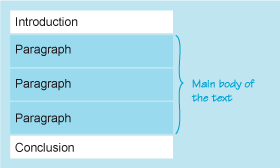
The image shows a table containing five sections. The top section is labelled ‘introduction’. Below the introduction are three more sections each labelled ‘paragraph’. These paragraphs are also labelled ‘main body of the text’. The bottom section is labelled ‘conclusion’.
Activity 3
The components of a typical article or book chapter are listed below. Match each component to its definition.
Paragraph
Discusses one specific topic.
Conclusion
Summarises the content of the main body of the text.
Introduction
Mentions the text’s content and organisation.
Main body of the text
Contains paragraphs and sections.
Using the following two lists, match each numbered item with the correct letter.
Paragraph
Conclusion
Introduction
Main body of the text
a.Summarises the content of the main body of the text.
b.Mentions the text’s content and organisation.
c.Discusses one specific topic.
d.Contains paragraphs and sections.
- 1 = c
- 2 = a
- 3 = b
- 4 = d
In this section you have seen how dictionaries, chapters and journal articles are organised. Other texts such as newspaper articles, web pages and fact sheets are organised differently. If you enrol on a university course, you will gradually learn to recognise the specific structure of different texts and this knowledge will help you when you read academic texts.
1.4 Where information sources are located
So far in this section you have looked at different types of information. If you go on to study at university, in your first year you will generally be provided with the required books and articles and other resources. Later on, you may be required to search for more information or you may simply be interested in finding out more about a specific topic.
To be able to do this, you need to know where to find sources that are relevant to you. In the next activity, you are shown different types of information source and asked to decide where they are most likely to be found.
Activity 4
Some examples of information sources are books, journal articles, references to chapters in books or journals, and daily news. Where would you be most likely to find these items? Choose between:
- libraries
- databases
- internet
- booksellers
- the media.
Note down your thoughts (either in the table below or on paper) about where you think each item can be found, before looking at the answers and comment below. In many cases it may not be a simple 'yes' or 'no', and the items could be found in numerous places.
| Libraries | Databases | Internet | Booksellers | The media | |
|---|---|---|---|---|---|
| Books |
To use this interactive functionality a free OU account is required. Sign in or register.
|
To use this interactive functionality a free OU account is required. Sign in or register.
|
To use this interactive functionality a free OU account is required. Sign in or register.
|
To use this interactive functionality a free OU account is required. Sign in or register.
|
To use this interactive functionality a free OU account is required. Sign in or register.
|
| Journal articles |
To use this interactive functionality a free OU account is required. Sign in or register.
|
To use this interactive functionality a free OU account is required. Sign in or register.
|
To use this interactive functionality a free OU account is required. Sign in or register.
|
To use this interactive functionality a free OU account is required. Sign in or register.
|
To use this interactive functionality a free OU account is required. Sign in or register.
|
| References to chapters in books or journals |
To use this interactive functionality a free OU account is required. Sign in or register.
|
To use this interactive functionality a free OU account is required. Sign in or register.
|
To use this interactive functionality a free OU account is required. Sign in or register.
|
To use this interactive functionality a free OU account is required. Sign in or register.
|
To use this interactive functionality a free OU account is required. Sign in or register.
|
| Daily news |
To use this interactive functionality a free OU account is required. Sign in or register.
|
To use this interactive functionality a free OU account is required. Sign in or register.
|
To use this interactive functionality a free OU account is required. Sign in or register.
|
To use this interactive functionality a free OU account is required. Sign in or register.
|
To use this interactive functionality a free OU account is required. Sign in or register.
|
Answer
| Libraries | Databases | Internet | Booksellers | The media | |
|---|---|---|---|---|---|
| Books | Yes, and also in booksellers and maybe on the internet | No | Possibly but usually not. | Yes, and also in libraries and possibly on the internet | Not usually |
| Journal articles | Yes, particularly university and college libraries | Yes, journal articles make up most database content | Yes, sometimes, but check if the journal articles are refereed or not | Not usually | Possibly, but the journal articles may not be refereed |
| References to chapters in books or journals | Yes, in indexes | Yes | Possibly | No | No |
| Daily news | Yes, libraries usually have daily news items | No | Yes, lots of news sites and e-newspapers | Not likely unless the bookseller sells newspapers too | Yes, also electronic news sites on the internet |
Comment
As you can see from this activity, depending on their type, these sources can normally be accessed online, through a library or from a newsagent. Some of these are freely available, but unless you are enrolled in a university degree, you will have to pay or purchase a subscription to view the full version of most specialised books, newspapers, magazines and online journals. These sources are readily available to current students through their university library.
2 Challenges and strategies
Finding the most appropriate texts is very important, but even more important is to make the most of them by reading them in an efficient and effective way.
In this section you will consider the main challenges that reading can pose and you will be introduced to some effective strategies.
2.1 The main challenges
Reading textbooks and other academic and specialist sources can be difficult for a range of reasons. In the following activity, you will consider the main challenges.
Activity 5
Think back to any long or complex texts you have read in the past. Your experiences may be from your school years or you may have read non-fiction books or long newspaper articles. What difficulties did you encounter? Did you develop any strategies to help you read such texts? Make some notes in the box below and then compare your experiences with those reported below.
Comment
Below is a list of some common reading difficulties experienced by some people when reading academic texts.
- I’m used to reading short pieces of writing. When I read long texts, I fall asleep.
- I read textbooks over and over to retain the information. It takes a lot of time and I still find it very difficult to remember what I read.
- I find reading difficult and I often lose concentration.
- I’m used to reading newspapers, but academic texts are harder to read. They are organised differently and contain many difficult words.
- English is not my first language, so I have to spend a long time looking up many words in the dictionary.
- Even if I understand every word, I sometimes don’t understand the
concepts explained in the books I read. - I try to take notes but I'm really lazy at ‘proper’ note taking – I don’t find it works for me as I never go back and read them.
- There is so much to read. I get lost and don’t know where to start.
You may have experienced similar difficulties. You may also have found ways to help you cope.
Academic and specialist texts may take longer to read than the texts you read every day and may contain a great deal of information about unfamiliar topics. They may also be structured differently from the texts you normally read. Therefore engaging with pieces of extended writing can be challenging unless you employ useful strategies. The next few activities will help you discover strategies to make reading easier.
2.2 Effective reading strategies
You are likely to already use some effective reading strategies in your day-to-day life. In this section you will read what some students say about their reading strategies and then compare them to your own.
Activity 6
It is useful to learn some strategies from people who are already reading academic texts.
Read what some current university students say about the way they read textbooks and other academic texts. Then answer the questions that follow.
- A.For my module, I have to read many chapters and articles. To keep concentrated, I always try to find a good reason for reading. One good reason is to read in order to find answers to the
assignment question, but I often think of my own questions. So before I start reading about a topic, I think about what I already know about it and what else I would like to know. Sometimes the materials give you some questions to consider while reading.- B.I think it also helps to read the introduction very carefully. It tells you what the chapter will be about and what you will be able to do after reading it. I find that it gives me the motivation to read.
- C.A good way to concentrate and remember what I read is to keep looking for ideas and examples that are relevant to me. So while I read, I ask myself: Does this happen to me or to people I know? Have I ever seen this? Do I agree? … It also helps to discuss what I have read with other students.
- D.I think it’s important to read actively. I read the key texts more than once. First I just check how long a chapter is, its headings, sections, images, and then I read it quickly to get a general idea, the
gist . When I know what the text is about, I read the key parts more carefully making notes. I find that making notes is a really good way to remember the content of the texts. I like using diagrams and tables and lots of colour. It helps me organise my ideas and remember what I read.- E.I don’t read all the texts in the same way. Sometimes, I just need to find a specific piece of information, for example a date or a particular topic, so I just read it quickly to find this information. But if, for example, I have to read about a complex theory, I will read very carefully and more than once.
Question 1
The students mentioned a variety of strategies but there were other useful ones they overlooked. Read the list below and try to identify which strategies weren’t mentioned. List them in the box with a note about why you think the strategy could be useful. Then compare your list with mine.
- Always read for a purpose.
- Before reading, ask yourself what you already know and what you want to learn about the topic.
- Write down some questions you hope the text will answer.
- Before reading a textbook chapter, check the learning outcomes.
- While reading, try to find information and theories that are relevant to you.
- While reading, keep asking yourself questions.
- As you read, record your thoughts in the margin or in a notebook.
- Read the same text two or three times. More may be necessary.
- Check the structure of the text before reading.
- When you read for the first time, look up only the words that are essential for understanding the text.
- When you read the second time, make notes.
- Try to use other information in the text to make sense of difficult words.
- Read differently depending on the purpose for reading.
Answer
The following strategies were not mentioned:
- Write down some questions you hope the text will answer. The student said they just think of some questions, but writing down those questions will help you to focus and structure your notes.
- As you read, record your thoughts in the margin or in a notebook. This is a good way to concentrate while reading. Sometimes your thoughts could be simple questions, such as ‘Why?’ or ‘How?’, which may make you want to reread certain parts or look for answers further in the text.
- When you read for the first time, look up only the words that are essential for understanding the text. This is sound advice: if you look up every word, you will probably lose track of what you are reading. It might be better to read whole paragraphs again to understand the general meaning before looking up words in the dictionary.
- Try to use other information in the text to make sense of difficult words. Sometimes the text in which these words are used can help you to understand their meaning.
Question 2
Read the list of reading strategies again.
- a.Which of the strategies do you already follow?
- b.Which of them is new to you?
- c.Which would you like to try?
Make some notes in the box below.
Comment
You may already be following many of the strategies mentioned by the students. For example, many of us look at the length and structure of a text before reading it and it is normal to have to reread longer documents. The strategies mentioned by the students can help you to extend the skills you already have.
Making use of reading strategies can help to overcome the challenges faced when reading long and complex texts and, in particular, academic and specialist sources. They can also help you to read more actively. Through the next few activities you will learn and practise an active learning method.
3 Reading actively
Being active as a reader is a good way to become more proficient and be able to take on more demanding texts.
In this section you will learn how to follow an active reading method consisting of five steps:
Skimming the text.- Recalling your background knowledge about its topic.
- Scanning for specific information.
- In-depth reading to find the key points.
- Making sense of texts containing difficult words.
These steps are outlined in the next five subsections and each has an activity associated with it. Some of these activities are based on the same piece of text. You will need access to a printer to print out that text in order to work on it.
3.1 Skimming the text
This reading strategy consists of reading the text quickly in order to find out what it is about and how it is organised. This can be done by reading its introduction as this is likely to briefly say what the text will be about. Titles, headings and subheadings also need to be read because they introduce the text and its sections and subsections. Visual representations of the content, such as images, diagrams and tables, can be used for the same purpose.
Finally, it is also very useful to read the first sentence of each paragraph. This sentence, which is called the topic sentence, is normally the first sentence of each paragraph and announces its topic.
Therefore, to quickly obtain information about the text, you can:
- read the title, the introduction, any headings and subheadings, and the conclusion
- read the first sentence of each paragraph (the topic sentence)
- read the concluding sentence of each paragraph
- read the words highlighted in bold
- look at illustrations (pictures, diagrams, tables).
As texts differ, you may not be able to follow all these strategies all of the time when skimming a text. For example, not all texts have illustrations or headings, and some short texts and extracts may not end with a conclusion.
To practise skim reading you are going to read a text taken from the Open University course KG004 Improving health and wellbeing. Download the text now.
Activity 7
Read only the introductory paragraph, the headings and the topic sentence of each paragraph. Then answer the questions that follow. I recommend printing out this text as you will refer to it again while working through the next few activities.
Question 1
Having skim read the text you should now have an overview of the information it contains. To see if you have, try to match the following statements to the paragraphs in which they were mentioned.
Paragraph 5
Over-nutrition in rich and poor countries
Paragraph 2
Under-nutrition in rich and poor countries
Paragraph 6
Negative effects of eating highly nutritious foods
Paragraph 7
Definition of type 2 diabetes
Paragraph 3
Effects of low calorie diets in children
Paragraph 4
Causes of under-nutrition
Using the following two lists, match each numbered item with the correct letter.
Paragraph 5
Paragraph 2
Paragraph 6
Paragraph 7
Paragraph 3
Paragraph 4
a.Under-nutrition in rich and poor countries
b.Definition of type 2 diabetes
c.Over-nutrition in rich and poor countries
d.Negative effects of eating highly nutritious foods
e.Causes of under-nutrition
f.Effects of low calorie diets in children
- 1 = c
- 2 = a
- 3 = d
- 4 = b
- 5 = f
- 6 = e
Question 2
Having skim read the text, which of the following headings best describes the topic of the whole text?
- Health issues in developing countries
- Forms of malnutrition
- Solutions to malnutrition
Answer
The correct answer is 2. Forms of malnutrition. The text is about the two forms of malnutrition: under-nutrition and over-nutrition.
Incorrect answers
Health issues in developing countries.
The text is not about health issues in general, but more specifically about nutrition. It considers malnutrition in both developing and developed countries.
Solutions to malnutrition.
None of the headings or the topic sentences mentions solutions. The introduction mentions the two forms of malnutrition and their effects.
Through skim reading you have learned a quick way to discover what the text is about and how it is organised. This information will help you decide what to read: all the text or only some sections. You will also be able to decide how you want to read the text.
3.2 Recalling your background knowledge about its topic
So far, you have gained information about the overall topic and organisation of the text. If your aim is to study this text in depth, you will now be able to recall your personal knowledge about its topic and think of questions you hope the text will answer for you.
Activity 8
Now spend a few minutes thinking about the text you read in Activity 7. Think about:
- what you already know about its topic
- any questions you think the text might answer.
Write a list of facts, ideas or questions below each of the following headings. I have started the lists for you.
Under-nutrition
Answer
The answer is personal to you, but here are some notes:
Under-nutrition
- Not eating enough
- Which nutrients are essential to avoid under-nutrition?
- Inudstrialised countries? — Causes?
Over-nutrition
- Eating too much
- Obesity
- More effects?
Comment
Depending on your previous knowledge of the topic of this text, you may have listed facts, ideas and questions or simply questions. Even if you listed only questions, you now have a purpose for reading the text: you are likely to want to compare your previous knowledge with the findings reported by the text and to find answers to your questions. University students may also want to read this text before writing an
3.3 Scanning for specific information
Having learned what the text is about and how it is organised, you may decide not to read it in depth but to just record some of the very specific information it contains. One reason for doing this may be because you are already familiar with the theme of the text and just need some details. In order to find this specific information, you need to scan the text.
Scanning consists of letting your eyes move quickly through the text until you find what you are looking for. As long as you know how the text is organised, this can be done quickly and without reading every word.
This is a technique many of us use every day. For example, I may scan the telephone directory to find a name. Or when I go to a restaurant, I scan the menu to find the vegetarian options.
Scanning texts is easy if you are familiar with their organisation. For example, I know that the menu of my favourite restaurant lists the main course under the heading ‘Mains’, so I scan this list looking for the word ‘vegetarian’, ‘vegetable’ or simply ‘V’.
In academic texts information is often grouped under headings, so to find a specific detail, you need to first locate the appropriate heading. If there are no headings, remember that the topic sentence of each paragraph is like a heading, as it tells you what the paragraph is about. In a paragraph, details can usually be found in the sentences that follow the topic sentence so this is where you need to look.
When you think you have found the relevant section or paragraph, look for key words or figures.
You will practise this skill in the following activity.
Activity 9
Using the understandings you gained from skim reading the text in Activity 7, quickly scan the text again to answer the following questions. Make your notes in the box below before looking at the answer.
- How many children are underweight?
- What percentage of children die because of under-nutrition?
- What diseases are caused by over-nutrition?
- Who develops type 2 diabetes – adults or children?
You will need to first select the relevant section. To answer questions 1 and 2, look for numbers and percentages. To answer questions 3 and 4 look for specific words.
Answer
To answer these questions successfully you needed to look for numbers and percentages as well as words describing diseases and the words adult and child.
- 100 million [P3].
- 35% [P3].
- Coronary heart disease, type 2 diabetes, gallstones, arthritis, high blood pressure and some types of cancer [P6].
- Both adults and children [P7].
Comment
This activity has shown that having gained an overview of a text, it is often possible to search for specific information by scanning it. This technique is very useful when you don’t need to read the text in depth. As you will see in the following section, if you wish to gain a full understanding of the text, you will need to read it again in depth while focusing on the main points.
3.4 In-depth reading to find the key points
If, after skimming the text, you decide to read it more closely and gain an in-depth understanding of its topic, the next step consists of reading the full text and identifying the key points. An effective way to identify key ideas is to highlight important parts of the text by underlining or using a highlighter pen.
This approach is designed to select and focus only on the core meanings of an extract. Highlighting involves making judgements about what is important. It is not about capturing every detail but getting a general overview of the key ideas.
Therefore, it is important to highlight only very few words and phrases in each paragraph. Paragraphs usually focus on one key point and, while they may include an illustrative example that may be useful, it is the main point that you need to identify first and foremost.
To illustrate this technique, I have highlighted the first two paragraphs of the text on malnutrition. (To be readable on screen, they are shown in bold rather than actually ‘highlighted’.)
[P1] To stay healthy, the body’s needs for energy and nutrients must be met. This is particularly important in growing children as damage inflicted may not be reversible and can affect normal development. People whose diet lacks the necessary nutrients suffer from malnutrition, a condition that includes both over-nutrition and under-nutrition and is considered a risk factor for health.
Under-nutrition
[P2] Under-nutrition is in news reports of famines in poor countries, but it can also be found in developed countries. In industrialised countries, under-nutrition can be seen in young people who have eating disorders such as anorexia nervosa or bulimia, where the amount of energy they consume in food is less than the needs of their body.
As you can see, in the first paragraph I have only highlighted the word ‘malnutrition’ and words that help to define it. In the second paragraph, I have highlighted words that refer to the location of under-nutrition (poor countries, industrialised countries), information about under-nutrition in industrialised countries (young people, eating disorders) and a definition of under-nutrition. I have not highlighted the examples.
You will find that more words and phrases need to be highlighted if a paragraph contains a great deal of core information. This is why several words and phrases are highlighted in paragraph 2.
The next activity gives you the opportunity to practise highlighting a text. You will need to print out the text and have a pen or highlighter pen handy.
Activity 10
If you haven’t already done so, download the text on malnutrition you skim read in Activity 7 and print it out. Read Paragraphs 3 to 7 and underline or highlight the key points they make. If you find new words, at this stage only look them up if they are essential to understand the overall meaning of a sentence. When you have finished, compare your highlighted text with mine.
Note: You will return to this text in a later activity so please keep your highlighted copy.
Answer
The key points are highlighted (in bold).
[P1] To stay healthy, the body’s needs for energy and nutrients must be met. This is particularly important in growing children as damage inflicted may not be reversible and can affect normal development. People whose diet lacks the necessary nutrients suffer from malnutrition, a condition that includes both over-nutrition and under-nutrition and is considered a risk factor for health.
Under-nutrition
[P2] Under-nutrition is in news reports of famines in poor countries, but it can also be found in developed countries. In industrialised countries, under-nutrition can be seen in young people who have eating disorders such as anorexia nervosa or bulimia, where the amount of energy they consume in food is less than the needs of their body.
[P3] If children’s diets are too low in energy, they will stop growing and gaining weight. They will become lethargic, less active and be unable to concentrate. If the situation continues, they may develop life-threatening diseases. The Food and Agriculture Organization of the United Nations (2012) reports that 100 million children under the age of five are underweight and 35% of all deaths of children under five are caused by malnutrition.
[P4] When people suffer from under-nutrition, they are often deficient in vitamins and minerals needed by the body. For example, they may not have enough Vitamin A. If this deficiency is not tackled, eyesight may be permanently damaged. Lack of iron is another very common form of deficiency. This helps to explain why about 50% of women in India suffer from some degree of anaemia.
Over-nutrition
[P5] Over-nutrition is usually associated with industrialised countries, although it is now also a problem among affluent people in developing countries. The main problem is that the amount of energy consumed in food is greater than the needs of the body and this can result in people becoming overweight or obese. As with under-nutrition, this may lead them to become lethargic, less active and less able to concentrate.
[P6] Further health problems will arise over time, particularly if the diet is high in saturated fat. Saturated fat is solid at room temperature; examples include animal fats, dairy products and coconut and palm oil. Eating a diet high in saturated fat raises blood cholesterol and the risk of heart disease. People who are overweight or obese are more likely to suffer from coronary heart disease, type 2 diabetes, gallstones, arthritis, high blood pressure and some types of cancer.
[P7] Type 2 diabetes is a metabolic disorder in which the body has trouble making its own insulin to control the level of sugar in the blood. Because it tends to develop in adults, it is also known as adult-onset diabetes. However, growing numbers of young adults and children are now developing it.
Comment
The number of words and phrases that you chose to highlight may differ from mine because we may have different perceptions regarding what is important in this text. However, we probably agree that the core information includes the types of people affected as well as the definitions, location, causes and effects of under-nutrition and over-nutrition.
What you highlight also depends on your purpose for reading. For example, if I were only interested in details about the likely effects of malnutrition, I would underline the examples as well.
3.5 Making sense of texts containing difficult words
An academic text may contain many words you don’t know, but it may still be possible to understand its content by following a range of strategies. You may already be familiar with these strategies as it is quite common, when coming across new words in everyday life, to try to work out their meaning from the context in which they are used. This context may include, for example, the pictures and other words that surround the text.
The advert shown in Figure 5, for example, contains terms I don’t fully understand, such as emphysema, but the other words in the list, the picture and my general knowledge about smoking help me understand that it must be a deadly disease. This contributes to my overall understanding of the message conveyed by the advert.
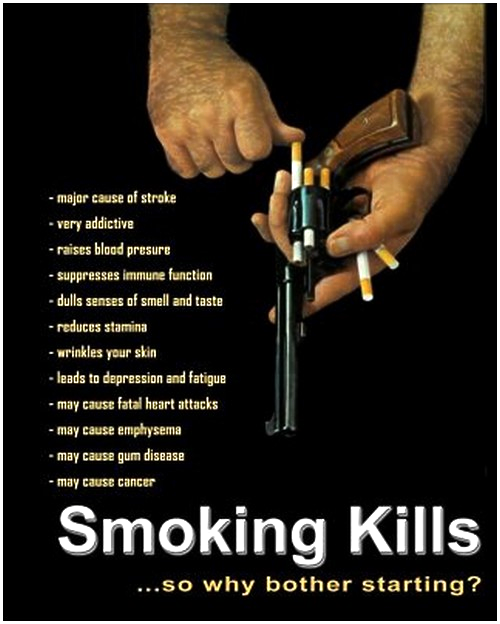
This is an advert that shows two hands loading a gun with cigarettes. Below the image is the question: Smoking kills…so why bother starting? Next to the image is the following list: major cause of stroke, very addictive, raises blood pressure, suppresses immune function, dulls senses of smell and taste, reduces stamina, wrinkles your skin, leads to depression and fatigue, may cause fatal heart attacks, may cause emphysema, may cause gum disease, may cause cancer.
Rather than looking up every word in the dictionary, experienced readers make sense of new words by drawing on the following strategies:
- their background knowledge about the topic
- the context in which a word is used: the words, sentences and examples that follow it
- their understanding about the way in which words are constructed in English
- their knowledge of other languages. Many academic words will be familiar if you have some knowledge of French or another language derived from Latin.
You will practise these strategies in the following activity.
Activity 11
Read the scenario below. What strategies could you use to help the student? Make some notes in the box below before looking at the answer.
Scenario
A fellow student is struggling to fully understand the following extract because it contains some words that are new to him. How might you help him use both his general knowledge about language and the context to understand the meaning of the words in bold?
Extract
When people suffer from under-nutrition, they are often deficient in vitamins and minerals needed by the body. For example, they may not have enough Vitamin A. They will become lethargic, less active and be unable to concentrate. If the situation continues, they may develop life-threatening diseases. The Food and Agriculture Organization of the United Nations (2012) reports that 100 million children under the age of five are underweight and 35% of all deaths of children under five are caused by malnutrition. People who are overweight or obese are more likely to suffer from coronary heart disease, type 2 diabetes, gallstones, arthritis, high blood pressure and some types of cancer.
Answer
Deficient
To understand this word you could use two strategies: context and knowledge of other languages. The word deficient becomes clear if you read the text around it. In other words, read the context in which deficient is used – in this case the example that follows. An example of a person who is deficient in vitamins is a person who doesn’t have Vitamin A. So deficient means ‘doesn’t have’ or ‘lacks’.
You could also draw on any knowledge you have of other languages. Deficient has very similar French, Spanish or Italian equivalents, so speaking these languages may help.
Lethargic
Lethargic is included in a list of other words so context again would be a useful strategy. Even if you don’t understand its meaning, from the context you will probably understand that lethargic describes one of the effects of malnutrition. This may be sufficient unless you want to read the text in more depth.
Life-threatening
Two strategies could be used to understand this word: context and separating the word into its two parts. The sentence that follows the one in which life-threatening is used provides more information as it explains that these children die. This means that life-threatening diseases are diseases that can cause loss of life.
You may also consider using your knowledge of other English words. Life-threatening is two words that can be understood separately – life and threatening.
Underweight
The strategy here is to recognise that underweight is made up of two words: under and weight. If you understand them separately, you may be able to understand that this word means less than the normal weight. Words such as under, over, mid- (as in midday), sub- (as in submarine) and un- (as in unfriendly) are called affixes and are often added to other words to change their meaning.
Gallstones
Again, context would be a useful strategy. From the context in which this word is used, it is possible to understand that this is a disease as it is part of a list of diseases from which obese people may suffer. Depending on the purpose for reading this text, you may decide that it is not essential to understand the word in order to gain a full understanding of this text.
The ability to use these strategies comes with practice. You may want to read regularly and use a paper or an online dictionary to look up only essential and key terms. If English is not your first language, it is also useful to read online news and good quality English language newspapers regularly. For example, you could try reading the news from one of the following websites:
In this section you have looked at an active reading method consisting of five steps. If your purpose for reading is to identify useful information that can be used in an essay or revised before an exam, you will also need to make notes. Note-making techniques are explained in the next section.
4 Making notes
Once you have identified the key ideas in a piece of text you are in a position to make some brief notes or jottings to prepare for an essay or to remember what you have learned from the article. Indeed, you may find that highlighting on its own may not help you to remember the ideas that you identified. Rather than returning to the highlighted text every time you want to revisit these ideas, only to find that what you have marked does not make sense to you any more, it is useful to develop a form of note taking.
The next activities give you an opportunity to practise note taking by:
- adding short notes into the margins of the highlighted text
- making notes in a notebook.
4.1 Adding short notes in the margins of highlighted texts
This type of note making can be used while reading and underlining the text. However, to gain a better understanding of the text, you may want to read it again and use this opportunity to add notes in the margin. These notes can consist of:
- key words
- definitions
- translations of new words
- comments
- reference to related resources
- questions.
When making short notes you need to be concise. Trying to get everything down is very time consuming and can result in notes as long as the article itself. One way to save time and keep your notes as short as possible is to make use of symbols, shorthand and abbreviations. You probably already know some short forms and you can add any others that you make up. A whole range of symbols and abbreviations can be used, some of which are reproduced below (Figure 6).
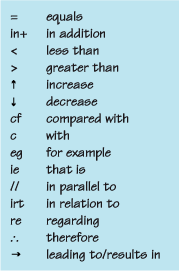
Note making symbols and abbreviations
= equals
in+ in addition
> – greater than
↑ – increase
↓ – down decrease
Cf. – compared with
C – with
e.g. – for example
i.e. – that is
// – in parallel to
i.r.t – in relation to
re. – regarding
(Three dots forming a triangle) – therefore
→ – leading to/result in
In addition, you can use your own form of shorthand, which sometimes entails leaving out vowels or cutting off the ends of words. This method is particularly effective where longer words are concerned. For example, concentrated becomes conc., advantage and disadvantage become adv. and disadv. respectively, and consequently becomes consq. Developing your own shorthand that makes sense to you can be extremely time efficient and after a while it becomes a language of your own that flows easily from the pen.
Figure 7 shows an annotated paragraph. The annotations reproduce the highlighted text using abbreviations. For example, NRG has been used to abbreviate energy and cntry to abbreviate countries.
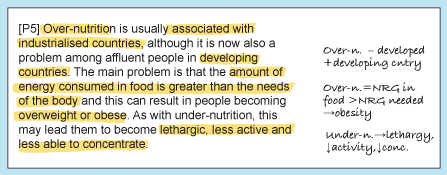
The following paragraph appears: [P5] Over-nutrition is usually associated with industrialised countries, although it is now also a problem among affluent people in developing countries. The main problem is that the amount of energy consumed in food is greater than the needs of the body and this can result in people becoming overweight or obese. As with under-nutrition, this may lead them to become lethargic, less active and less able to concentrate.
The following annotations accompanying the paragraph: Over-n. – developed+developing cntry
Over-n.=NRG in food
Over-n.→lethargy,↓activity,↓conc.
As you read, you may also want to add annotations that help to define new words, ask questions or refer to specific pages in other sources. In addition, while making sense of the text, some readers may add annotations that help to explain ideas and relationships, or add an example that they may not highlight but that still needs to be understood or may be useful at a later date. This is illustrated in Figure 8.
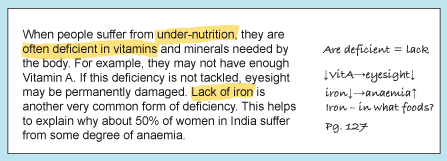
The following paragraph appears: When people suffer from under-nutrition, they are often deficient in vitamins and minerals needed by the body. For example, they may not have enough Vitamin A. If this deficiency is not tackled, eyesight may be permanently damaged. Lack of iron is another very common form of deficiency. This helps explain why about 50 % of women in India suffer from some degree of anaemia.
The following annotations accompanying the paragraph:
Are deficient= lack
↓VitA→eyesight↓
iron↓→anaemia↑
Iron- in what foods?
Pg.127
If you don’t mind writing on hard copy or in books, this method of note making can be effective. As space is limited, this technique encourages you to be selective and reduce the key information to just a few words and/or symbols. Thinking of and recording questions helps you to predict and prepare for the content of the following paragraphs and therefore process the information they contain.
4.2 Making notes in a notebook
Getting key ideas down in shorthand form is also useful when making notes in a notebook. You will practise this technique in the following activity.
Activity 12
Read the 'Improving health and wellbeing' text again and make some brief notes. Try to write as concisely as you can. For example, these are the notes I made after reading the first paragraph (Figure 9).

The notes the author made against the first paragraph of the practice text: malnutrition: under-nutrition – over-nutrition → health risks
After you finish making your notes compare them with mine.
Answer
Figure 10 shows the notes I made on the text.
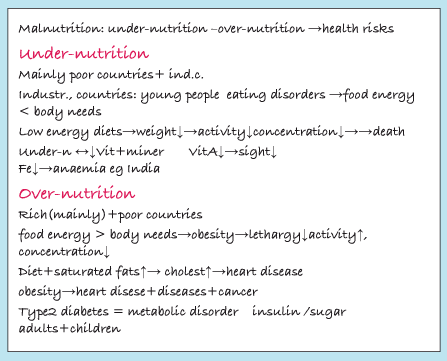
Malnutrition: under-nutrition –over-nutrition →health risks
Under-nutrition
Mainly poor countries+ ind.c.
Industr. ,countries: young people eating disorders →food energy
Low energy diets→weight↓→activity↓concentration↓→→death
Under-n ↔↓Vit+miner VitA↓→sight↓ Fe↓→anaemia eg India
Over-nutrition
Rich(mainly)+poor countries
food energy > body needs→obesity→lethargy↓activity↑,concentration↓
Diet+saturated fats↑→ cholest↑→heart disease
obesity→heart disese+diseases+cancer
Type2 diabetes= metabolic disorder insulin /sugar adults+children
This strategy is effective because it forces you to select the most important information and, in particular, the information that will help you to write your essay or prepare for an exam.
The drawback with this strategy is that these notes just reproduce the key ideas in the order followed by the original text. To gain a deeper understanding of the text and to remember the key information it contains, you need to reorganise your notes in a way that is meaningful and memorable to you.
5 Reorganising notes
To remember the content of your notes, it is useful to process and reorganise the ideas they contain. This is particularly useful for those notes that you will be drawing upon for planning and writing assignments. They can be reworked and key concepts and ideas can be applied to different types of question and issue.
Ways of processing and regrouping ideas include:
- organising information into subtopics
- using a
mind map - using a table.
Each person finds the ways that are most useful for them and that best fit each text they read. You may need to experiment with different methods to find the ones that suit you. The activities contained in the next three sections provide opportunities to do this. If you have time attempt all three; otherwise try the method you are least familiar with and simply look at my answers to the other two activities.
5.1 Organising information into subtopics
Rather than writing notes that list the information in the order followed by the source text, you may decide to use your own organisation. You will practise this in the following activity.
Activity 13
As you saw in previous activities, the practice text provides information about causes, effects and location of over-nutrition and under-nutrition. Focusing on these topics can help you to reorganise your notes.
Go over the practice text and your previous notes again and organise the information using the headings below. Where useful, you may want to include some examples. To increase the effectiveness of these notes, try to use very concise expressions.
When you finish compare your work with my answer. You can make your notes either in the boxes provided below or on paper if you prefer.
Answer
My answer contains information I felt would be useful when discussing the topic of malnutrition. You may have chosen slightly different information.
As you see, I have used very concise expressions. Reducing information to concise expressions is a skill you will practise in Week 8.
Under-nutrition
Causes:
Eating disorders (in developed countries): anorexia, bulimia
Low energy diet
Scarcity of food (famine)
Effects:
Lethargy, low activity levels, low concentration
Stunted growth, weight loss
Long term/in children: diseases leading to death
Vitamin (e.g. Vit A→sight loss) and mineral (e.g. iron→anaemia) deficiency
Where?
Developing countries – mostly
Developed countries
Over-nutrition
Causes:
Excessive food intake
Saturated fats-rich diets (dairy products, animal fats, coconut/palm oil)
Effects:
Lethargy, low activity levels, low concentration
Weight gain, obesity
Effects of obesity: coronary heart disease, gallstones, arthritis, cancer, type 2 diabetes, high blood pressure
Type 2 diabetes: metabolic problems, mostly adults+children
Where?
Developing countries – mostly
Developed countries
5.2 Using a mind map
If you prefer to create a visual representation of the key ideas contained in the texts you read, you can use a mind map. A mind map is a diagram showing a key idea and other associated ideas and information. The key idea is at the centre of the diagram and the other concepts stem from it.
Activity 14
Below is a mind map whose branches show the main topics dealt with by the 'Improving health and wellbeing' text. As you can see, there are two main branches that relate to the two main topics: over-nutrition and under-nutrition. From each of these branches stem three sub-branches that relate to the three main subtopics: causes, effects and location.
Download a PDF of this mind map then print it out. Populate this mind map by adding more branches to the three sub-branches. You can reuse the same words used in the answer to Activity 13 or your own words. However, as space is limited, you will need to be very concise and you may want to omit some less essential information.
When you have finished, compare your mind map with mine.
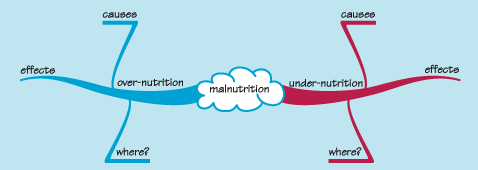
At the centre of this diagram is a bubble containing the text: malnutrition. From this bubble stem two branches. One branch is labelled under-nutrition and the other is labelled over-nutrition. From each branch stem three branches labelled in the same way. The labels are: causes, effects and where?
Answer
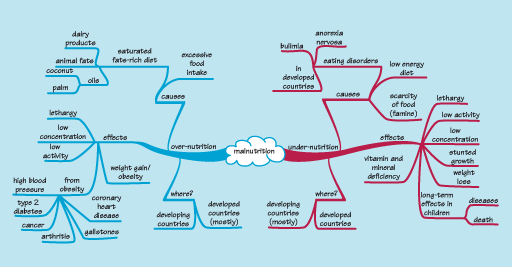
At the centre of this diagram is a bubble containing the text: malnutrition. From this bubble stem two main branches. One branch is labelled under-nutrition and the other is labelled over-nutrition. [new paragraph] From the branch labelled under-nutrition stem three branches labelled : causes, effects and where? From the branch labelled ‘causes’ stem three more branches: scarcity of food (famine), low energy diet and eating disorders. From this last branch stem three branches labelled as: anorexia nervosa, bulimia and in developed countries. [new paragraph] From the branch labelled ‘effects’ stem six branches labelled as: lethargy, low activity, low concentration, stunted growth, weight loss, vitamin and mineral deficiency, long-term effects on children. From this last branch stem two branches labelled diseases and death. [new paragraph] From the branch labelled ‘where?’ stem two further branches labelled developed countries and developing countries (mostly).From the branch labelled over-nutrition stem three branches labelled causes, effects and where? From the branch labelled ‘causes’ stem two more branches labelled excessive food intake and saturated-fat rich diet. From this last branch stem three further branches labelled diary products, animal fats and oils. From the branch labelled oils, stem two further branches labelled coconut and palm.From the branch labelled ‘effects’ stem five branches labelled as lethargy, low concentration, low activity, weight gain/obesity, from obesity. From the branch labelled from obesity, stem six further branches labelled high blood pressure, type 2 diabetes, cancer, arthritis, gallstones, coronary heart disease. [new paragraph] From the branch labelled ‘where?’ stem two further branches labelled developed countries (mostly) and developing countries .
Some people find diagrammatic representations, such as mind maps, can be more memorable, particularly when revising for exams. However, due to lack of space, it is not always possible to enter every detail in a mind map. For example, my mind map does not contain details about type 2 diabetes. I left it out because space was limited and I felt that this detail was not essential.
5.3 Using a table
Information taken from the texts you read can also be reorganised using a table. A table is particularly useful in reorganising the 'Improving health and wellbeing' text, because it allows you to easily compare the causes, the effects and the location of the two forms of malnutrition. Compared to a mind map, a table allows you to include more information.
Activity 15
Make a copy of the table below and use it to enter information contained in the 'Improving health and wellbeing' text. You may want to reuse the same words used in the answer to Activity 13 or your own words.
| Under-nutrition | Over-nutrition | |
|---|---|---|
| Causes | ||
| Effects | ||
| Where? |
Answer
These are the points I felt would be useful when planning and writing an essay. You may have chosen different ones.
| Under-nutrition | Over-nutrition | |
|---|---|---|
| Causes |
|
|
| Effects |
|
|
| Where? |
|
|
This section has introduced you to three ways to reorganise information taken from the texts you read. The way you reorganise ideas depends on the content of the text. For example, the organisation and content of the practice text about malnutrition lent itself to all three methods.
Additional questions, ideas and examples can be added at a later date. For example, if you become a university student, you will want to make links to ideas presented elsewhere in your course materials, or something you have read in a newspaper might provide you with a useful illustration. It is a good idea, then, to get into the habit of revisiting your notes at intervals throughout your studies to develop links, introduce new questions and examples, and thus continually reprocess key ideas.
6 This week's quiz
Well done, you’ve just completed the last of the activities for this week's study before the weekly quiz.
Go to:
Open the quiz in a new tab or window (by holding ctrl [or cmd on a Mac] when you click the link).
7 Summary
This week you have looked at the types of text that university students need to read and at the most effective reading and note-making strategies.
These are the most important learning points:
- University students need to read books, journals, specialised websites and reference texts.
- Reading academic texts can be difficult and requires a strategic approach.
- It is important to have a reason for reading.
- The most effective strategy consists in reading actively.
- Skimming, scanning and predicting the content of the text are active reading techniques.
- Skimming helps to decide how you want to read a text.
- Underlining words and/or phrases helps you to select and focus on the key points in a text.
- Difficult words can sometimes be guessed from the context.
- Adding notes in the margin and writing brief jottings are useful note-making techniques.
- To remember the content of your readings, it is useful to reorganise your notes using headings, mind maps and tables.
You can now go to Week 2.
References
Acknowledgements
This course was written by Anna Calvi.
Except for third party materials and otherwise stated (see FAQs), this content is made available under a Creative Commons Attribution-NonCommercial-ShareAlike 4.0 Licence.
The material acknowledged below is Proprietary and used under licence (not subject to Creative Commons Licence). Grateful acknowledgement is made to the following sources for permission to reproduce material in this unit:
Images
Figure 1: Desk, © javaturtle on Flickr made available under https://creativecommons.org/ licenses/ by-nc-sa/ 2.0/; Figure 4: Child writing/drawing © Henry Burrows (Foilman) on Flickr made available under https://creativecommons.org/ licenses/ by-sa/ 2.0/ deed.en; Figure 6: http://www.moolf.com/ amazing/ top-10-anti-smoking-ads.html.
Every effort has been made to contact copyright owners. If any have been inadvertently overlooked, the publishers will be pleased to make the necessary arrangements at the first opportunity.
Don't miss out:
1. Join over 200,000 students, currently studying with The Open University – http://www.open.ac.uk/ choose/ ou/ open-content
2. Enjoyed this? Find out more about this topic or browse all our free course materials on OpenLearn – http://www.open.edu/ openlearn/
3. Outside the UK? We have students in over a hundred countries studying online qualifications – http://www.openuniversity.edu/ – including an MBA at our triple accredited Business School.
Copyright © 2014 The Open University